Attention! 1. The air conditioning system line is under high pressure. Until the complete removal of the refrigerant, it is forbidden to disconnect any hoses and remove the units of the air conditioning system. The removal of the refrigerant must be carried out in a car service.
2. The air conditioning system on models since 1995 is charged with R-134a refrigerant, which is incompatible with R-12 in terms of lubricating properties. It is not allowed to charge R-134a into a compressor running on R-12 and vice versa, otherwise the compressor will be damaged.
3. Suburban models are equipped with an optional air conditioning system. The auxiliary air conditioner evaporator is mounted at the rear of the vehicle.
1. Caring for the air conditioner is reduced to the following procedures.
A). Checking the condition and tension of the compressor drive belt, replacing the belt.
- b). Checking the condition of hoses and tubes (do not disconnect the line!)
- V). Cleaning the intercostal spaces of the condenser and drain tube.
- G). Checking the system refrigerant charge.
2. The air conditioner should be turned on every month for about 10 minutes.
3. The most common cause of poor air conditioner performance is insufficient refrigerant charge. If there is a noticeable increase in air temperature from the air conditioner, then check the completeness of the refrigerant charge.
4. To check the coolant charge, warm up the engine.
5. Move the temperature control lever to the Cold position, the mode selection lever to the Norm position, and the fan speed control lever to the Hi position. Open the doors and hood.
6. Check that the compressor turns on, when the magnetic clutch clicks and the central part of the clutch begins to rotate.
7. Compare the temperature of the evaporator inlet tube and accumulator outlet tube. If the temperature to the touch is slightly different, then refueling is necessary (see photo).

